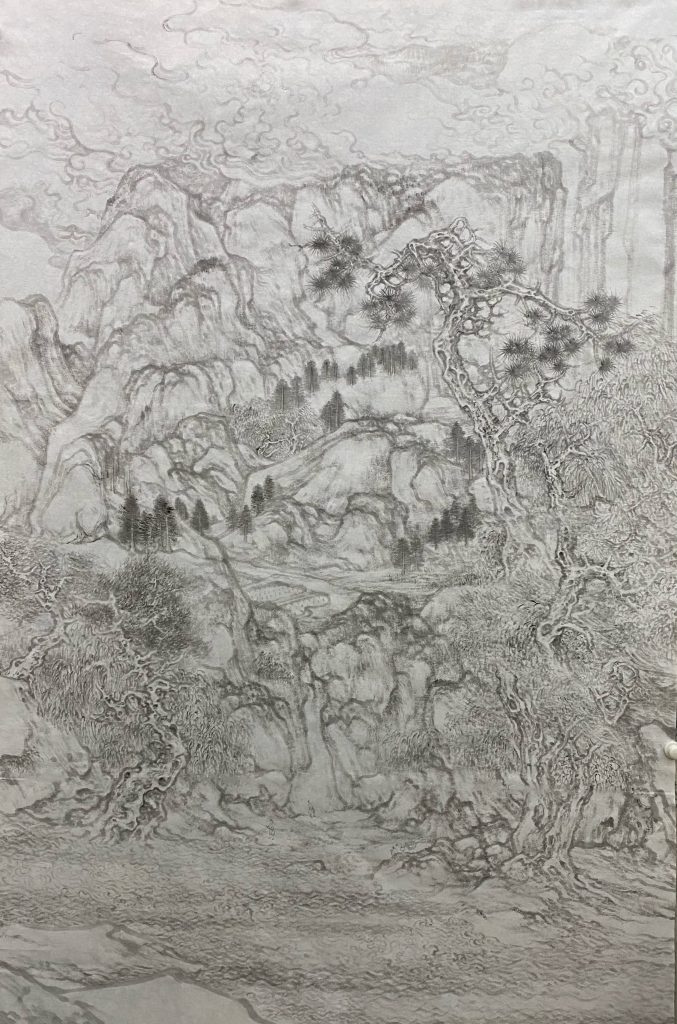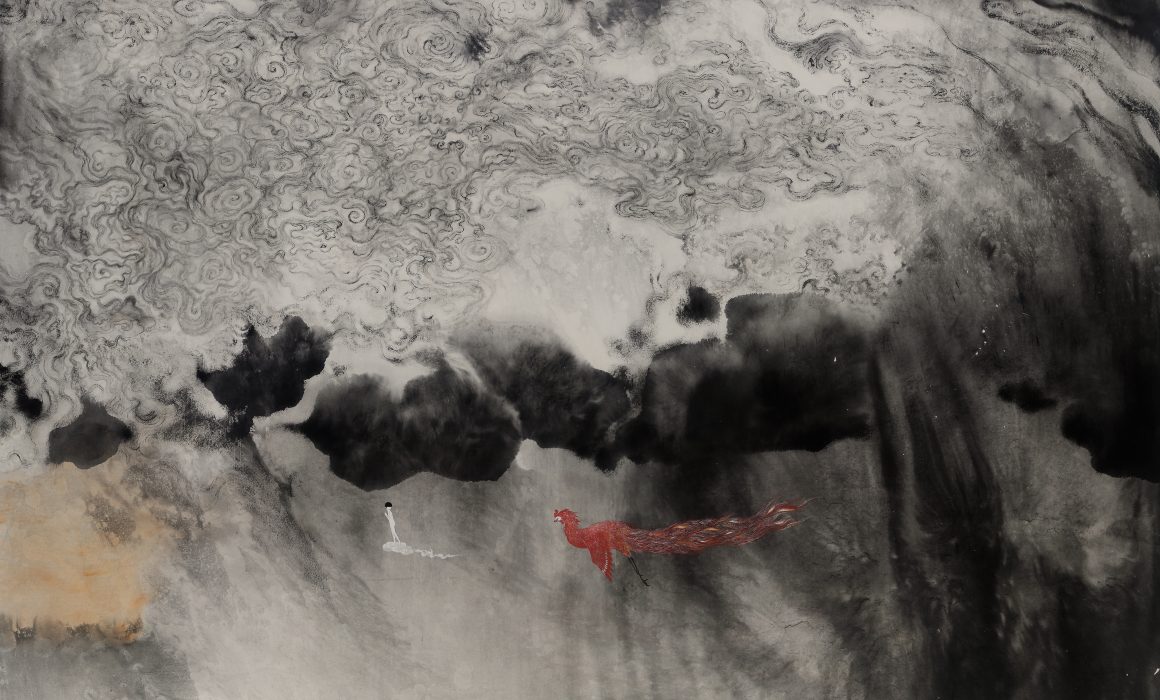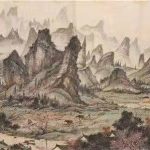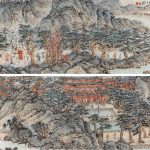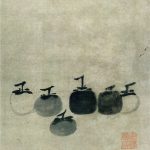观画:思于林涛与云影之间 – Looking at Lin Yusi’s 林于思 paintings: Thinking about the soughing of the wind in the forest and the reflection of the clouds
By; 李公明 Li Gongming
Transated by; Giacomo Bruni
在我看来,林于思的水墨艺术世界有两个不同的层面。
第一个层面很综合、很全面。从美院到画院、从传统到当代,林于思的专业训练很全面,创作心态很开放,可以说是兼收并蓄。他自述说“各种妥协的结果就是我现在画出来的画面,工笔,写意,山水,花鸟,人物,一挥而就和细工慢活全部放在一起。” 这是他的水墨创作的真实状况,一个多元开放的多面体:左手工笔右手写意,辰时白猫卯时重彩,立根传统面向当代跨界实验,上午慢工细活下午疾风泼墨,天上飞鸟神仙妖精妖怪,地下大佬小人胖子瘦鬼鹿马猫猴,有山有水有林有石,西洋东洋可控可防,正剧卡通亦庄亦谐,儒道仙佛各显神通,诗情画意经典俗典,光明幽暗正能负能……。
In my opinion, Lin Yusi’s ink art world has two different levels.
The first level is very comprehensive and synthetical. From the academy of fine arts to painting academy, from tradition to contemporary, Lin Yusi’s professional training is very extensive, and his creative mentality is very open, which can be said to be eclectic. He stated that “the result of all kinds of compromises is my actual painting, that comprehends fine brushwork, freehand brushwork, landscapes painting, flowers and birds painting, figure painting, all with a single wave and fine workmanship merged together.” This is the true state of his ink art creation, a multifaceted, open and polyhedric: he uses both the fine brush as well as the expressive brush techniques. First, the fine outline drawing, then a heavy coloring, strongly rooted in the tradition in the direction of contemporary cross-border experiments, slow work in the morning, blast of ink in the afternoon, supernatural flying birds in the sky, evil spirits and demons, on the ground important old people, little fat guys, thin ghosts, deer, horses, cats and monkeys, there are mountains, waters, forests and rocks, western and eastern oceans are under control, both solemn and humorous, Confucian and Taoist immortals, Buddhas, each of them showing their magical powers, poetic charm of the classics and the popular culture, brightness and darkness, positive and negative…
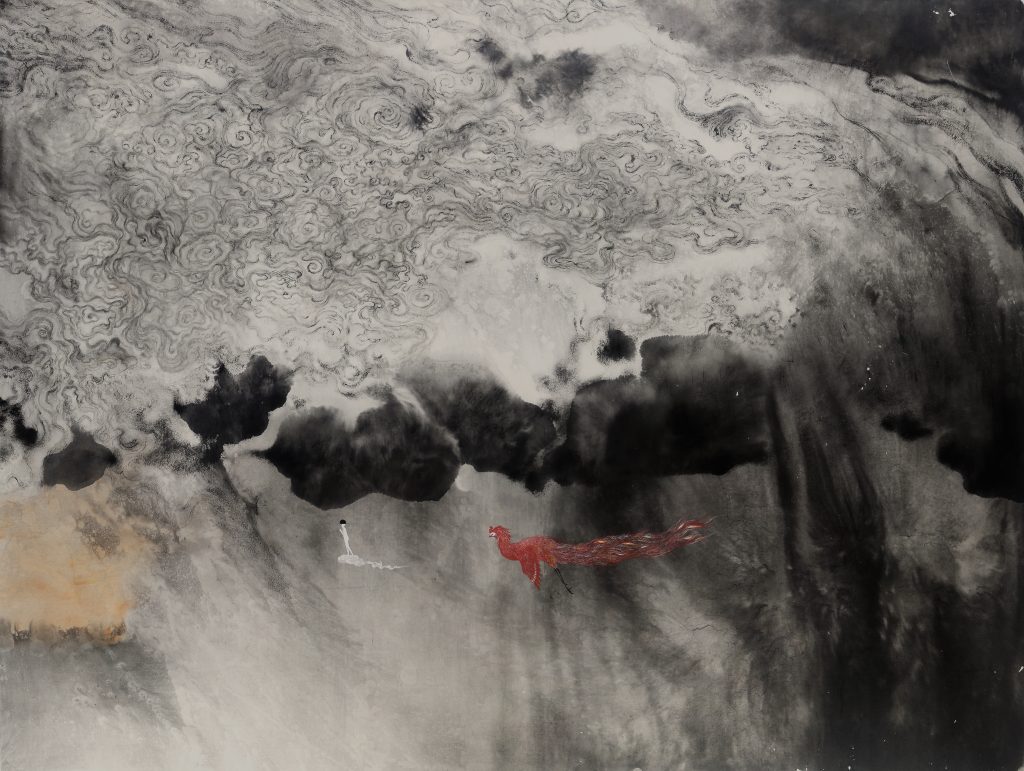
支撑这个水墨艺术多面体的基础首先是他对传统与手艺的尊重,他对如何运用材料、工具以及运用的熟练程度非常重视,“例如宣纸的渗透性和毛笔的弹性以及水区别于油的流淌性”,在墨法与赋彩、熟宣与生宣的张力之间,视觉上审美判断和追求依赖于与材料、技法心手相随的运用,可控可防与控而不防都各有挑战性。这是艺术手艺人的看家本领和伟大传统,是对技与道的关系的经验诠释。面对作品,真伪高下永远骗不了手艺人的眼睛,因为“每个人画出来的不同的线条和点都可以告诉我们这些信息。”作为手艺人无论你走到哪里,“你最好能体现你是如何‘从传统中来’的。”林于思有自觉的敬畏传统和手艺人意识,这是他在当代水墨江湖中打天下的基础。
The foundation that supports this polyhedric ink art is first of all his respect for tradition and craftsmanship. He attaches great importance to how to use materials, tools, and proficiency in the application, “such as the permeability of Xuan paper and the elasticity of brushes, and the fluidity of water that differs from oil.” In the tension between ink technique and coloring, between processed xuan paper and raw xuan paper, visually aesthetic judgments and pursuits rely on the use of materials and techniques, and at the same time, controllable and preventable, the challenge of what is unexpectable that can not be controlled or prevented. This is the art of craftsmanship skills and the great tradition, that is the empirical annotation of the relationship between technique and Dao, the way. Facing the work, the authenticity and the quality of the work can never deceive the eyes of the craftsman, because “the different lines and dots drawn by each person can tell us this information.” As a craftsman, wherever you go, “you better be able to reflect how you’ve come from tradition’.” Lin Yusi has a conscious awe of the tradition and a sense of craftsmanship. This is the foundation for him to conquer the world of contemporary ink painting.
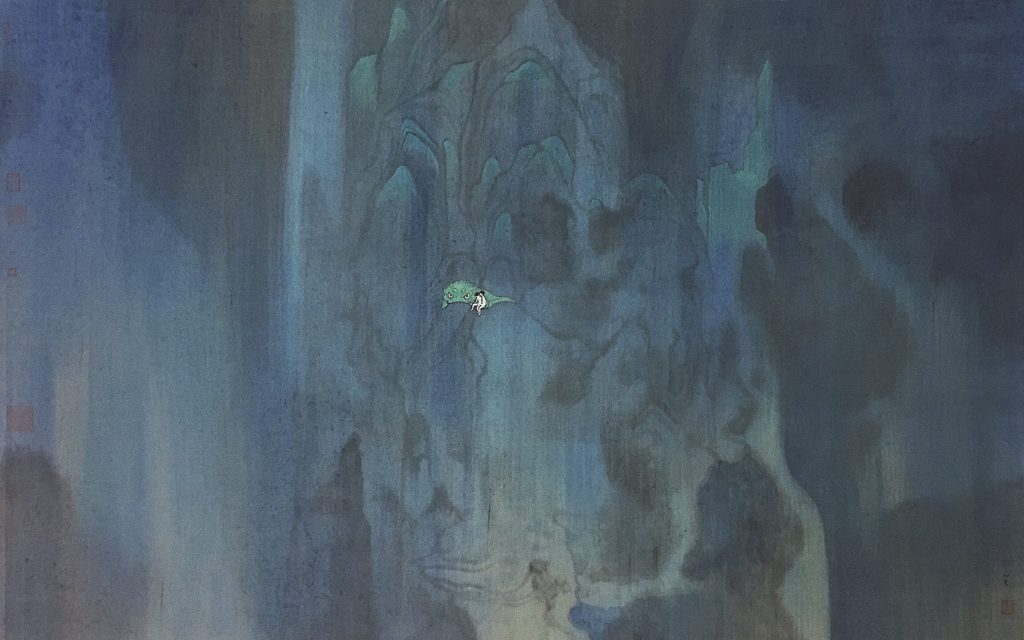
林于思的水墨艺术还有第二个层面,即个性化和创造性的层面,是在打天下的过程中孤标独立、成就自我。这时,手艺隐匿,艺道证成。“在这种状态下,技法、材料、圈子、派系,通通都会失效。你一定是在表达一个纯粹的‘你’……这是绘画,真实的绘画。这也是对待一切事物应该有的姿态。”他说“我是个‘游心者’,在自己心里有一个世界,我总是在自己的那个世界里看到一切,描绘一切。”于是他感到“这世间唯一的花就是七色花,每一个花瓣的颜色都不同,是为神奇的存在。”;“律己自证,每个人都是世间唯一的花。”
The second level of Lin Yusi’s ink art expresses individuality and creativity, which is independent and self-achieving in the process of its success. The craft is hidden, and the art is evident. “In this situation, all techniques, materials, artistic circles, and schools will all fail. You must express a pure ‘you’, this is painting, real painting. This is also the attitude needed to have when dealing with everything.” He said, “I am a ‘wanderer of the heart’. I have a world in my heart. I always see everything and portray everything in my own world.” He feels that “the only flower in this world is the seven-colored flower. The color of each petal is different, it is a magical existence.”; “Self-discipline proves everyone in the world belongs to the same flower..”
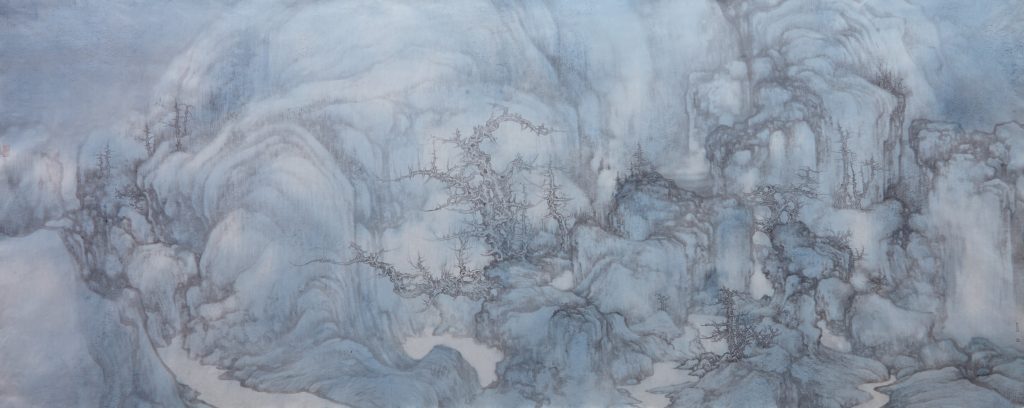
于是,随着兴之所至、心之所思,他自由地穿越在抒情与叙事、寂静与喧哗、幻境与现实等多元的审美面向之间,多样化就是他的个性化。那么,“多样化的尝试会模糊一个艺术家的面目吗?我想也未必,毕竟我们在讨论梦幻般存在的七色花的时候可以尽情美好,但没人关心过它会结出怎样的果子,这证明了结果并不重要。”他说结果不重要,是因为在过程中他已然尽情领悟和体验了“游心”之美。他发现“最美好的东西总是在虚无之间的,在小河边,大树下,荒草丛中,山水之间。对岸的烟花,让我们一起来欣赏它。”说得比较浅显,但正是在这个“虚无之间”,他显示了独特的自我。山水树石、云深雾障,在墨彩的勾染化氲中出现闲寂悠远的气息,这还不是他的独特所在——如果仅仅是这样,他的水墨世界的第二个层面也就很一般了。所谓孤标独立、成就自我,需要有更为个性化的精神创造,需要有一种源自个体心灵的强烈变奏。这是第二个层面最关键的因素和过程。
Therefore, with the pursuit of happiness and the thoughts of his heart, he freely travels between lyric and narrative, silence and noise, illusion and reality and other multiple aesthetic aspects. These varieties are his personalization. When asked if with the attempt of diversification, if it’s possible to blur the face of an artist, he replied, “I don’t think so. After all, we can enjoy the beauty when discussing the dreamlike Seven-Colored Flower, but no one cares what kind of fruit it will bear. It proves that the result is not important.” He said that the result is not important because he has fully comprehended and experienced the beauty of wandering the heart “youxin” in the process. He found that “the most beautiful things are always between nothingness, beside the small river, under the big trees, among the wild grasses, among the mountains and rivers. The lovely spring scene on the opposite bank, lets us enjoy it together.” The words are relatively simple, but it is in this “between nothingness” that he shows his unique self. Mountains, waters, trees, rocks, clouds and deep fog barriers, in the expression of the ink and color and its atmosphere appear an empty, still and remote flavor. This is not his only uniqueness, if it was, the second level of his ink painting world would be very general and ordinary. The so-called solitary standard of independence and self-achievement requires a more personalized spiritual creation and a strong variation from the individual’s heart, which is the most critical factor and process of the second level.
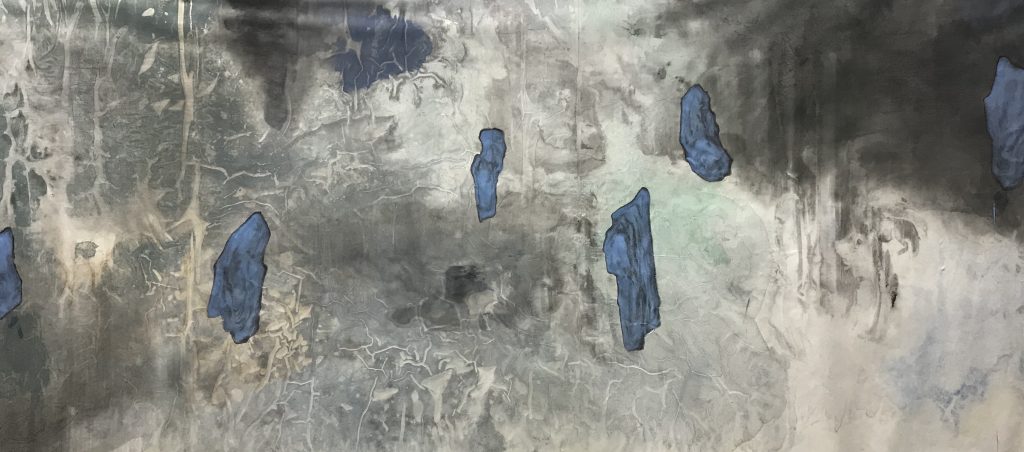
另外,除了艺术家的自我挑战、自我证成之外,艺术的第二个层面也是对观者的召唤和挑战,是对创造性的回应与欣赏的过程。观画,“观”什么?艺术史家达尼埃尔·阿拉斯(Daniel Arasse)警告观者说“我们什么也没看见”,他指出许多图像志学者看似博闻强识,其实却远离作品,根本看不见它们,甚至相信作品具有唯一的正确含义。他提醒我们不要“忽视作品自身的魅力”,他要我们思考:什么是艺术家最想要我们看的东西?
In addition, besides the self-challenge and self-accomplishment of the artist, the second level of art is also a call and challenge to the viewer, a process of creative response and appreciation. What is “viewing” when looking at a painting? The art historian Daniel Arasse warned viewers that “we saw nothing”. He pointed out that many iconographic scholars who seem to be erudite and widely knowledgeable, in fact, are far away from the works, unable to see them at all, and even believe the work has only one correct meaning. He reminds us not to “ignore the charm of the work itself”. He wants us to think: What is the thing that the artist wants us to see most?
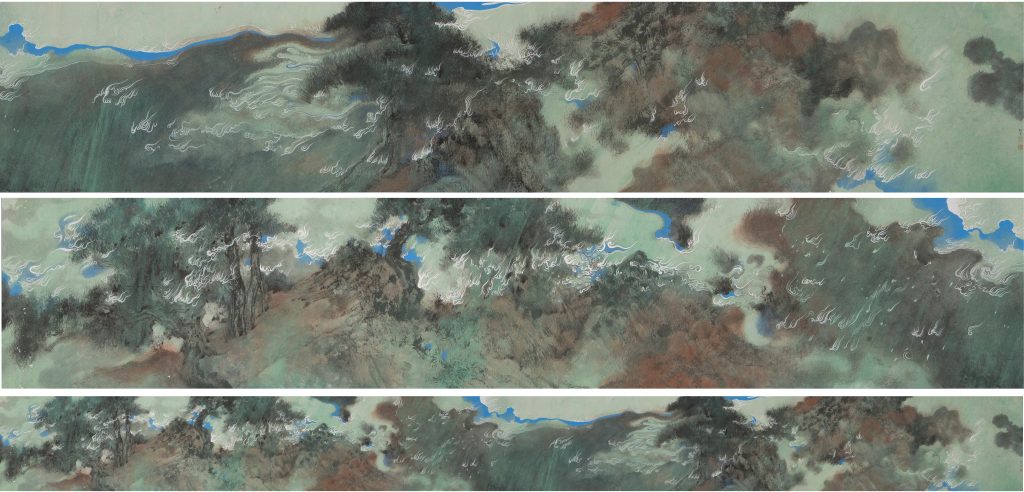
这就是在第二个层面上的观与思,在林于思的作品面前,思于林涛与云影之间。
林于思的作品带有众多创造性的变奏,如抒情中的叙事变奏、古典中的当代变奏、严肃中的荒诞变奏等等,更有玄妙意趣的是小人儿与各种灵兽之间的关系变奏,那是从古典传奇、卡通漫画中幻化而来的自我与他者镜像,是叙事与抒情的直觉吟唱。在法国诗人、文学评论家和艺术史家伊夫•博纳富瓦的启发下,我意识到“隐匿的国度”和“无法企及的潜在”可能就是我试图在林于思的水墨世界中寻觅的感受。
This is the second level of observation and thinking. In front of Lin Yusi’s works, thinking is between the soughing of the wind in the forest and the image of the clouds.
Lin Yusi’s works contain many creative variations, such as emotional and narrative variations, classical and contemporary variations, serious and absurd variations, and so on. What’s more mysterious and intriguing is the relationship between the little man and the mythological beasts coming from classical legends and cartoons, their variation is the mirror image of the self and the other, it is an intuitive singing of narrative and lyricism. Inspired by the French poet, literary critic and art historian Yves Bonnefoy, I realized that “hinterland” and “unattainable potential” may be the kind of feeling I tried to find in Lin Yusi’s ink world.
博纳富瓦认为绘画表达的很多东西恰恰是诗人尝试用语言表达的,甚至有时绘画比诗歌更容易表达。他以“隐匿的国度”来描述艺术,在他看来艺术的王国永远是隐匿的,就如生命、死亡、时间、空间等都属于“隐匿的国度”一样。那么,“隐匿”是什么意思?博纳富瓦没有、也不会给它下定义。转过头来看林于思的画,你可能会理解“隐匿”是一种时空关系,是曙色依稀的迷茫时分与被灰霾笼罩的土地,或者是月黑风高之夜与在草丛中闪着亮光的凶器,就如博纳富瓦所吟唱的:“当你倒在贫瘠的大地,/ 我要把承受过你的闪光叫做虚无……。”(博纳富瓦 《真正的名字》)隐匿是一种期待和召唤,被期待和被召唤的是林涛与云影。 “有一些作品会对无法企及的潜在有所启发。比如普桑《弹鲁特琴的酒神女祭司》中的蓝色,就包含那种风雨欲来的瞬疾,那种我们的意识不可或缺的非理念的明智。”普桑的这幅画收藏在卢浮宫,我很有可能曾经不止一次在它面前匆匆走过,仅仅因为它不是《阿卡迪亚的牧羊人》。“蓝色”为什么会“包含那种风雨欲来的瞬疾”?而“那种风雨欲来的瞬疾”与“非理念的明智”又有何联系?
Bonnefoy believes that many things that paintings express are exactly what the poets try to express in words, and sometimes paintings are easier to express than poetry. He described art as a “hinterland”. In his opinion, the kingdom of art is always hidden, just as life, death, time, space, etc. all of them belong to the “hinterland”. So, what does “hinterland” mean? Bonnefoy does not and will not define it. Turning your head to look at Lin Yusi’s paintings, you might understand that “hinterland” is a time-space relationship, the time of confusion and the land shrouded in haze, or the dark night with high winds and the reflection of a sparkling murder weapon, as Bonnefoy sings: “When you fall on the barren ground, / I will name the lightning that carried you nothing.” (Bonnefoy, Vrai nom) Concealment is a kind of expectation and summoning. It is the soughing of the wind in the forest and the image of the clouds that are expected and summoned. “There are certain works that can, for all that, give us a fair idea of the impossible potential. The blue in Nicolas Poussin’s Bacchanal with Guitar Player has that stormly immediacy, that non-conceptual clear-sightedness for which our whole consciousness craves.” This painting of Poussin is in the Louvre, and I have probably hurried past it more than once, just because it is not Et in Arcadia ego. Why does “blue” “have that stormly immediacy”? And what is the connection between the “stormly immediacy” and “that non-conceptual clear-sightedness”?
其实根本不需要、也不应该向诗人提出这样逻辑性诘问,我们只需要向自己提问:我们是否领悟过什么是作品中那些“无法企及的潜在”? 在林于思的作品前我也会有这种自我提问。画家还很年青,不会是岁月的沧桑使他对时光被侵蚀有如此浓缩与质朴的体验。我想是因为他对隐匿在艺术中的时光有近乎天生的敏感,或许他知道草木会凋零,知道会有海枯石烂的一天,知道一切都会在时光尘土中朽烂,于是把一切都隐匿在虚幻不实的意境之中。这是一种“无法企及的潜在。”
In fact, there is no need and one should not ask the poets such logical questions. We only need to ask ourselves: Have we ever realized what is the “impossible potential” in the work? I also had this kind of self-doubt while looking at Lin Yusi’s work. The painter is still very young, and it’s not the vicissitudes of time that gives him such a condensed and unadorned experience of the erosion of time. I think it’s because he is almost innately sensitive to the time hidden in art. Perhaps he knows that the vegetation will wither, that there will be a day when the sea will dry and the rocks will crumble, and that everything will decay in the dust of time, so he hides everything in the artistic conception of illusion. This is a kind of “impossible potential.”
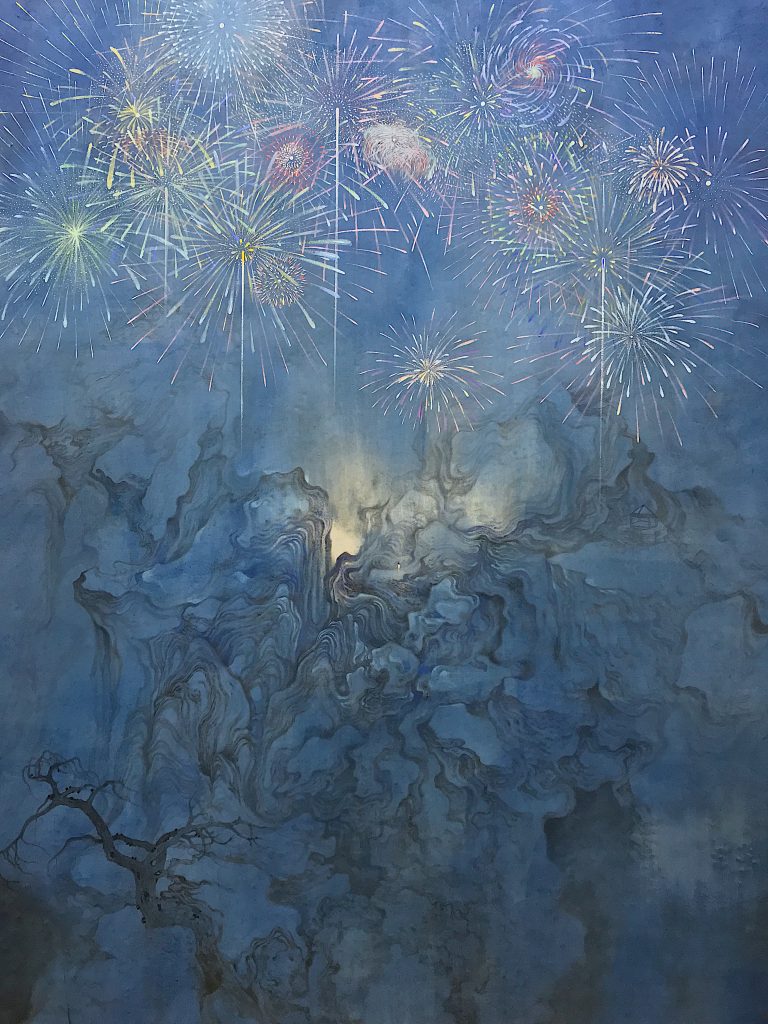
无论他笔下出现的是山还是树,不管是清晰还是朦胧,我感觉都有同一束诗意的、灵性的微光把它们缀联起来。这束微光来自我所理解的“隐匿的国度”的内在逻辑性,以及来自在我想象中画家内心对这种被隐匿的逻辑性的想象与揭示——在一堆石头与另一堆石头、一片树林与另一片树林之间,有同样会倒流的时光、同样顽强的生命、同样腐烂的死亡气息把它们的命运连结起来。于是在林于思的笔下,它们只能被光与暗影所笼罩、所界定,这就是“无法企及的潜在”。
No matter whether it is a mountain or a tree, whether it is clear or hazy, I feel that they are connected by the same poetic and spiritual gleam. This glimmer comes from the internal logic of the “hinterland” as I understand it, from my imagination and from the artist’s imagination and disclosure of this hidden logic – between one pile of stones and another pile of stones, one forest and another, there is the same flowing back of time, the same tenacious life, the same rotten breath of death that connects their destiny. Therefore, under Lin Yusi’s brush they can only be shrouded and defined by light and shadow, which is the “impossible potential”.
无论他笔下出现的是山还是树,不管是清晰还是朦胧,我感觉都有同一束诗意的、灵性的微光把它们缀联起来。这束微光来自我所理解的“隐匿的国度”的内在逻辑性,以及来自在我想象中画家内心对这种被隐匿的逻辑性的想象与揭示——在一堆石头与另一堆石头、一片树林与另一片树林之间,有同样会倒流的时光、同样顽强的生命、同样腐烂的死亡气息把它们的命运连结起来。于是在林于思的笔下,它们只能被光与暗影所笼罩、所界定,这就是“无法企及的潜在”。
No matter whether it is a mountain or a tree, whether it is clear or hazy, I feel that they are connected by the same poetic and spiritual gleam. This glimmer comes from the internal logic of the “hinterland” as I understand it, from my imagination and from the artist’s imagination and disclosure of this hidden logic – between one pile of stones and another pile of stones, one forest and another, there is the same flowing back of time, the same tenacious life, the same rotten breath of death that connects their destiny. Therefore, under Lin Yusi’s brush they can only be shrouded and defined by light and shadow, which is the “impossible potential”.
在古希腊人看来,对世界的认知与“看”和“灵知”不看分割。柏拉图主义认为知识的概念不是一个纯粹的世俗概念和认识论问题,而是包含有视觉的、超验的和灵知的意味,是在“看”中获得对自我的认知和拯救。灵知论者狄奥多托(Theodotos)说:“使我们获得解放的不仅是洗礼,还有这种认识:我们曾经是谁?我们曾经成为什么?我们曾经身处何方?我们被抛向何方?我们匆匆赶向何方?我们从哪儿获得解放?什么是生?什么是重生?”。这对于我们思考林于思的画或许有某种启发性,就如博纳富瓦对于“艺术”的理解也带有这种灵知主义的色彩,他说“最后我们必将在疑问中结束这种欣赏,最高级的作品揭示了一个决绝的存在。”在看与灵知之中,让“隐匿的国度”在遥远的地平线上敞开,这是博纳富瓦的诗意之光和林于思的画境之光所负载的使命。
In the eyes of the ancient Greeks, cognition of the world is not separated from “seeing” and “gnosis”. Platonism believes that the concept of knowledge is not a purely secular concept and epistemological problem, but contains visual, transcendental, and lucid meanings, which is to gain cognition and salvation of oneself in “seeing”. The Gnostic critic Theodotus said: “But it is not only the baptism that is liberating, but the knowledge of who we were, and what we have become, where we were or where we were placed, whither we hasten, from what we are redeemed, what birth is and what rebirth.” This may be instructive for us to think about Lin Yusi’s paintings, just as Bonnefoy’s understanding of “art” also has this kind of Gnosticism. He said, “Finally, we will end this appreciation in doubt, the highest work reveals a decisive existence.” (Y. Bonnefoy 2012) Seeing and knowing (gnosis), let the “hinterland” open on the distant horizon. This is the mission carried by Bonnefoy’s poetic brightness and Lin Yusi’s painting luminosity.
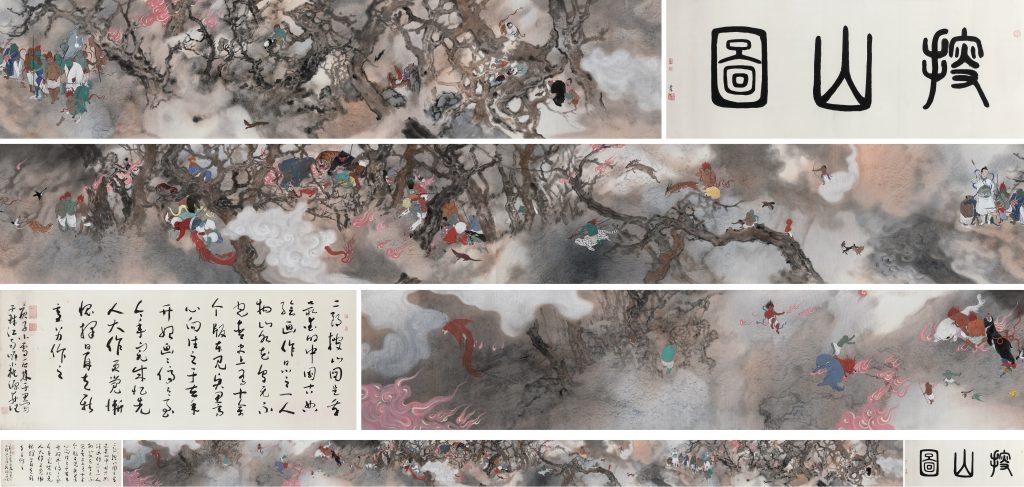
林于思的水墨与古希腊的“灵知主义”在我心目中的邂逅可能只是昙花一现,那种想法在刹那的绽放之后就可能被雨打风吹去,但是只要曾经存在,他的画在我眼中已经打上了隐匿的精神烙印。
毫无疑问,在林于思的作品可以看到他敏感于风景的所有细节、光线中的任何变化,但是我无法肯定的是,他在所有的这些细节和变化中有过什么样的预感。 落叶缤纷,花瓣也在飘落,世界依然安静。这是最适合沉思的时分,思于林涛与云影之间,思于绘画与诗歌之间。这种思最终让我们明白路还很长,天地太大,归家是最甜美的想象。于是有一种沧桑中的美感,令人想起江河最终流入大海时那一段无言的呜咽与辉煌。
The encounter between Lin Yusi’s ink art and the ancient Greek “Gnosticism” in my mind may only be a flash in the pan, and that idea may be blown away by the rain and wind after a moment of blooming, but as long as it has ever existed, his paintings in my eyes have been branded with hidden spirit.
Undoubtedly, in Lin Yusi’s works, you can see that he is sensitive to all the details of the landscape and any changes in the light, but I can’t be sure what kind of premonition he has in all these details and changes. The falling leaves are rich and colorful, also the petals are falling, and the world is still quiet. This is the most suitable time for contemplation, thinking between the soughing of the wind in the forest and the image of the clouds, thinking between painting and poetry. This kind of thinking finally made us understand that the road is still long, the world is too big, and returning home is the sweetest imagination. So there is a sense of beauty in the vicissitudes of life, reminiscent of the silent lament and glory when the river finally flows into the sea.
Read the full magazine
